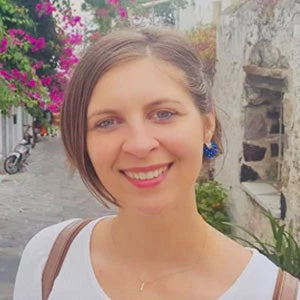
This blog post is part of a special series titled "Spatial Insights into the Gender Employment Gap", powered by the World Bank's Geospatial Operations Support Team. Read the series' first and second installments.
Did you know that something as simple as the distance to a bus stop or the absence of streetlights can significantly influence a woman's decision about whether—and where—to seek employment? Geographic factors play a crucial role in shaping women's lives, directly impacting their ability to access and sustain jobs. From the availability of essential services and digital inclusion to the risks posed by natural disasters and crime, geography influences nearly every aspect of a woman's life. Despite this profound connection between location and gender equity, spatial factors are often overlooked in policy and planning. To bridge this gap, the World Bank’s Geospatial Operations Support Team (GOST) in collaboration with the Institute for Economic Development has developed a free, self-paced online course: Geographic Considerations in Evaluating Women’s Employment Opportunities.
This course explores how spatial dynamics affect women’s workforce participation and provides practical tools for integrating geospatial insights into gender equity initiatives. Designed for policymakers, researchers, development professionals, university students, and anyone interested in exploring the intersection of gender and geography, the course offers insights into the ways infrastructure, transportation, and environmental conditions impact economic opportunities for women.
The course will launch on April 1st, and enrollment is now open (register here!).
What you will learn
Through a series of animated videos, interactive activities and forums, participants will examine and discuss the three dimensions of the Geospatial Women’s Employment Analytical Framework (GeoWEAF) and its 15 factors, gaining practical insights into its real-world applications. GeoWEAF is a framework designed to assess how geographic factors influence women’s access to employment, helping to uncover spatial barriers and identify pathways toward more inclusive economic opportunities.

We will explore issues such as:
How inadequate street lighting increases insecurity, restricting women’s mobility and limiting their access to employment.
How unreliable public transportation forces women to accept lower-paying jobs closer to home.
How living far from educational and training facilities affects women’s career advancement.
How environmental hazards, such as flooding or landslides, disproportionately impact women’s ability to work and study.
Evolution of GeoWEAF
The course builds on the World Bank’s efforts to integrate geographic insights into gender equality initiatives. In in line with the World Bank Group’s Gender Strategy 2024–2030, GeoWEAF was launched in 2024 as a tool for assessing how supportive an environment is for women’s employment.
Initially, the framework comprised four key dimensions: Individual, Accessibility, Contextual, and Place Characterization. The Individual Dimension examined personal characteristics such as age, number of children, and marital status. However, in 2025, the framework was updated to focus exclusively on location-specific characteristics, shifting the emphasis from individual circumstances to external environmental factors that influence access to job opportunities (Geography!).
As a result, GeoWEAF now consists of three dimensions:
The Contextual Dimension, which examines regulatory frameworks and policies that promote gender-inclusive employment.
The Accessibility Dimension, which assesses the availability and proximity of essential services such as transportation, childcare, and healthcare.
The Place Characterization Dimension, which evaluates the physical and social characteristics of a location, including a new focus on the vulnerability of women to natural disasters and environmental risks.
The Gender Enabling Environments Spatial Tool (GEEST) supported the application of the updated GeoWEAF in Saint Lucia, in a case study that identified areas suitable for gender-inclusive employment in the Renewable Energy Sector. The study has been published in the journal Energy Research & Social Science and demonstrated how spatial data, when combined with a gender lens, can help design more effective interventions to support women’s economic participation.
Join us to discover solutions that support women’s economic opportunities
Sign up to our online course today to refine your skills and contribute to shaping more equitable employment opportunities for women!Learn to apply GeoWEAF in real-world contexts, and gainthe skills to examine how infrastructure, transportation networks, environmental risks, and policy frameworks shape female labor market opportunities. Rather than simply identifying challenges, the course encourages a data-driven approach to developing solutions that support more inclusive economic participation.
Interested in how you can leverage these resources for your work? We’d love to hear from you. Reach out to the Geospatial Operational Support Team (GOST) at gost@worldbank.org




Join the Conversation